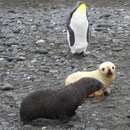Diagnostic Description
provided by FAO species catalogs
The muzzle is short and moderately pointed. The nose does not extend much past the mouth, is not bulbous, and the nostrils point ahead. The ear pinnae are long, prominent, and naked at the tip. The creamy white vibrissae of adults are very long, particularly in bulls; some are the longest of any pinniped (up to 35 to 50 cm). The foreflippers are about one-third, and hindflippers slightly more than one-fourth, the total length. Adult males develop a mane on the chest, neck, and top of the head. There is an enlargement of this area with muscle and fat that occurs with maturity. Adult females and subadults are medium grey, occasionally darker above, and paler below. There is usually a pale blaze on the flanks, extending towards the hindflippers. The chest and underside of the neck are palest; this pale colour extends onto the sides and back of the neck. The muzzle and face are also marked with lighter areas. Additional lighter areas often surround and highlight the ears, particularly in adult females and subadults. The tops of the flippers are generally darker than the back. At birth, pups are blackish, though they may be pale on the face and muzzle, and some animals are paler below. Adult males are dark greyish brown to charcoal, with frosting on the guard hairs of the back, mane, and flanks (these guard hairs often bunch up and reveal the fawn coloured underfur). There is an unusual pale (yellowish off-white to honey) form of the Antarctic fur seal that occurs infrequently. The dental formula is I 3/2, C 1/1, PC 6/5. Can be confused with: Antarctic fur seals might be confused with many southern otariids, most notably: Subantarctic fur seal, South American fur seal, Juan Fernandez fur seal, South African fur seal, and New Zealand fur seal, and South American sea lion and Hooker's sea lion. To distinguish bulls of the different fur seals, note overall size, characteristics of the muzzle and nose, coloration, relative length of the flippers, and length of the vibrissae (keeping in mind that vibrissae may be broken off).In some cases, it may not be possible to separate adult female and subadult fur seals. Most useful are body shape, coloration, vibrissae, ear size, eye shape, and flipper size and shape.
- bibliographic citation
- Marine mammals of the world. Jefferson, T.A., S. Leatherwood & M.A. Webber - 1993. FAO species identification guide. Rome, FAO. 320 p. 587 figs. .
- author
- Food and Agriculture Organization of the UN
Size
provided by FAO species catalogs
Adult males are up to 2 m long and weigh 110 to 230 kg, females up to 1.4 m and 22 to 51 kg. Newborns are about 63 to 67 cm and 6 to 7 kg.
- bibliographic citation
- Marine mammals of the world. Jefferson, T.A., S. Leatherwood & M.A. Webber - 1993. FAO species identification guide. Rome, FAO. 320 p. 587 figs. .
- author
- Food and Agriculture Organization of the UN
Brief Summary
provided by FAO species catalogs
Breeding is from late November to late December. After they mate and wean their pups, females disperse widely, possibly migrating north. Bulls also depart breeding areas, but subadults and adults can be seen around the rookeries at South Georgia all year. Like other fur seals, Antarctic fur seals porpoise when swimming rapidly. When rafting they often assume the typical fur seal resting posture. At other times, they can be found busily engaged in grooming. Antarctic fur seals, especially adult females, feed heavily on krill, but also take fish in summer. Dietary patterns of females in summer indicate nocturnal feeding.
- bibliographic citation
- Marine mammals of the world. Jefferson, T.A., S. Leatherwood & M.A. Webber - 1993. FAO species identification guide. Rome, FAO. 320 p. 587 figs. .
- author
- Food and Agriculture Organization of the UN
Benefits
provided by FAO species catalogs
Conservation Status : This species was nearly exterminated by sealers. Harvesting occurred with numerous highs and lows in activity from the late 18th until the early 20th Century. Estimates are that only a few hundred may have survived. Rapid population growth occurred from 1958 to 1972 and slower but continuous growth from that point until the present. Although the population of Antarctic fur seals is still growing, entanglement of these seals in debris at a rate of 0.1 to 1% at South Georgia may become a factor in the stability of this species. IUCN: Insufficiently known.
- bibliographic citation
- Marine mammals of the world. Jefferson, T.A., S. Leatherwood & M.A. Webber - 1993. FAO species identification guide. Rome, FAO. 320 p. 587 figs. .
- author
- Food and Agriculture Organization of the UN

